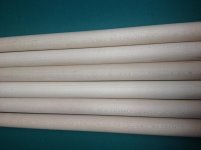Why would you assume I have no idea about the timber industry? Because I don't purchase large volumes of specialty lumber? Because I'm a cue maker? Contrarily, I know the supply side of the industry fairly well, mostly from a logging point of view. I know how much mills pay for logs, and how much mills cost to operate. Bare with me while I break it down.
Consider a mill pays $900-$1200/mbf of prime hard maple log, and they average 25% waste on each log. One log with 1,000bf of volume costs them around $1000. Assuming the logs are delivered, they are $1/bf deep before they even begin milling. Take off 25% waste & they are $1.25 deep. If operation costs run in the neighborhood of $.10/bf then they are $1350 deep into a 750bf stack of green lumber. Depending on kiln type, it's fair to say they'll spend a nickel per bf per day, on a six week cycle they will be another $1700 into the endeavor. That's a little over $3G's so far for 750bf of shaft quality maple, considering there are no losses to degrade. The mill itself has paid $4/bf, and thus far it's only lumber, not shafts. That's absolute factual current market pricing. I'll have to speculate to go farther, based on my own experience.
If the mill processes the wood into shaft squares itself, then there will be about 35% loss to lacking quality and defects. That leaves 490bf remaining of the original 1000bf log. Considering there are 2.5 shafts/bf of lumber, they end up with 1225 shafts. That has them gross deep at $2.50/shaft and they haven't yet paid their laborers to process and grade the lumber into shafts. Assuming they are $3/shaft their cost after all expenses and everything went well, if they sold 20,000 shafts at $6/ea for a $3:50% profit then they gross $60G's for themselves. Seems like a good chunk off the cuff but when you begin factoring overhead and time into the mix, that profit gets much slimmer on the net. Now how often do you or anybody else buy 20,000 shafts at a time? Is it often enough to keep a mill and its employees with a solid income?
Point being, the cost of cutting is nearly prohibitive. If the stars were aligned and labor was cheap, it could almost be feasible for a small specialty outfit to make a go of it. $60G's is a single family income, and it would take several employees & a fairly immense facility to produce 20,000 shaft orders. If there were 10 people between the office to the kid running the tablesaw, that would mean 200,000 shafts/yr to keep the mill operating. I'm not so easily inclined to believe there are 200,000 shafts produced globally in a year, yet alone from a single supplier. That leaves me to conclude that in order for $6 shafts to exist, they are indeed not premium grade. Keep in mind this assumes every single shaft from the mill is cue worthy. Considering that no cue maker works at the mill, I have my doubts. Again, 20,000 at a time or not, $6 shafts are a thing of times past. Is it possible that somebody can supply quality shafts at high volume and only pay themselves poverty wage? Yes I suppose so, and if that's what you have on your hands then great for you. However, better sense & logic contradicts that. Given that a prime maple log has no run out, shafts produced from it will have no run out. Straight grain, clean shafts are what I'm talking about. Not talking coring dowels or second hand quality stuff, just straight clean grain. No mill I know can do it sustainably for $6. In Atlas' case as a retail seller, it's essentially impossible. That's not knocking Atlas. You get what you pay for & if they are selling $6 shafts then what can anybody expect?

